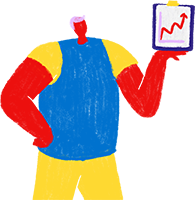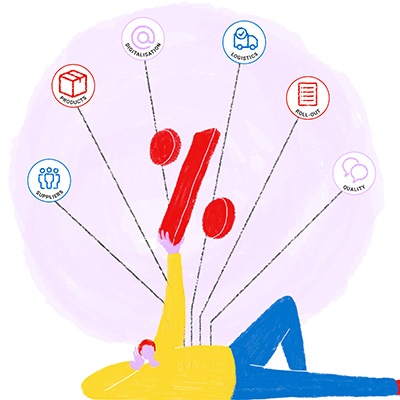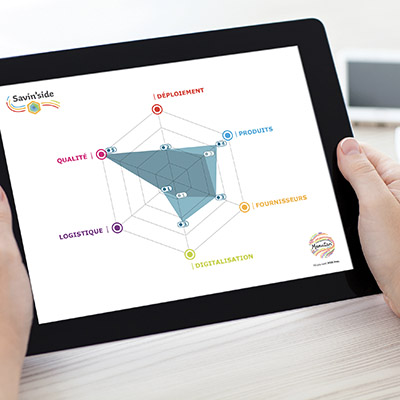Information technology is omnipresent in the current socio-economic life. This umbrella term encompasses all the information-processing technologies that have revolutionised the world of work and the way it is organised. Of course, the procurement function is no exception. Applied to the field of procurement, these professional tools, services, and techniques derived from information technology are formidable efficiency levers and offer many new opportunities.
Definition of information technology
Information technology, often equated with the computer system, includes:
- The computer hardware used by staff, i.e. computers, tablets, smartphones, printers, etc.;
- Software used in companies, such as word processing programs, accounting software, etc.;
- Data storage and management systems in companies, like databases, servers, ERP (Enterprise Resource Planning), etc.;
- Computer networks.
Constantly evolving, these technologies are used to create, process, store, secure and exchange all kinds of data and information. Teamed with the digitalisation of communication systems, information technology has resulted in the use of a more common terminology: Information and communication technologies (ICT) or even new information and communication technologies (NICT). This extended concept covers telecommunications, computing and audiovisual, with the same common denominator centred on data, which is a key resource for companies.
Information technology supporting procurement
In today’s uncertain and volatile environment, it is vital for procurement departments to be able to increase their agility and efficiency. One of the most effective levers to achieve this is to take the digital transformation within the company a step further. According to the content of a recent Deloitte study, three quarters of procurement decision makers see it as one of their priorities.
The question is no longer when but rather how to start, support, or accelerate this digital shift through acquiring knowledge and experience in information technology. Nowadays, there are many different IT solutions, even if there are major trends for each sector, each business, and each specific need.
According to the latest GEP study entitled "CPO Study 2022", procurement decision makers have identified two major technology solutions that give them the most value: Cloud platforms and Procure-to-Pay solutions. These are followed by remote working solutions, Source-to-Contract solutions, Supply Chain collaboration solutions and supplier self-service portals
Cloud platforms
By definition, these technologies enable their users to store, manage and process data through computer services hosted on the internet rather than on a local server or a computer. Cloud platforms are increasingly popular with procurement teams who view them as a genuine efficiency lever.
In fact, they help to automate processes and improve their operational agility thanks to mobile and real-time work online. One other advantage is that they also make a lot of savings in terms of accounting, as they do not require any investment in infrastructure and the subscription principle gives them a certain predictability. Finally, these solutions evolve at the company’s pace, adjusting to variations in the volume and/or scope of activities with agility.
Procure-to-Pay solutions
These technical resources aim to make the entire process Procure-to-Pay paperless, from product searches to invoice payment. Because these processes are particularly time-consuming, repetitive and without any real added value for the teams, they are the ideal candidates for going digital.
Today, lots of procurement departments are initiating their digital transformation plan through e-procurement solutions (which covers management of the electronic catalogue as well as order request and approval). Such solutions enable you to reduce transactional costs, increase productivity, get a clear overview of spending, as well as to cut down on the company’s environmental impact.
The blockchain
This new technology means that information can be stored and sent transparently and securely. It is a large database that is open to everybody and records all transactions, without any possible falsification. Combined with smart contracts that makes fulfilling contracts easier, it provides additional security and reduces operational costs. For example, it can automatically release payments once the supplier has fulfilled their contractual demands.
Ultimately, these technologies contribute to achieving the same goals: Reducing manual tasks, boosting process efficiency, and building powerful databases. All of them are levers that buyers appreciate as the latter still spend almost three quarters of their time on purely operational tasks[1], which generates quantities of data to be used.
Information technology to boost strategy
Skills and even expertise in information technology are now essential for managing procurement strategies suited to each company’s priorities.
For example, using the technologies mentioned above means companies can make procurement processes smoother or even automated while controlling expenditure. These are particularly relevant levers when it comes to simple procurement optimisation strategies. This means all the purchases that have a low financial commitment and a low overall risk in the company, according to the Kraljic matrix.
To optimise this category, procurement departments generally focus on process efficiency, product standardisation and prescriber autonomy. Among others, these benefits are provided by the electronic catalogues and approval flows of e-procurement solutions or by the accessibility that the cloud offers users.
In addition to these technologies, which are well known to the procurement function, next generation tools can also be integrated to guarantee greater agility and intelligence in project management. For example, SRM software (Supplier Relationship Management) helps to improve supplier relations, control risks and capture innovation. Similarly, a performance evaluation module will help the procurement function to demonstrate its results, adjust its strategy if necessary and establish its strategic positioning.
In this age of technological revolution, the possibilities are almost endless! Whether they are modules to integrate into your procurement solution or customised solutions, such as machine learning, predictive analysis and, more generally, artificial intelligence solutions, these technologies open the path to smart procurement. By choosing the right solutions, procurement departments can overcome the challenges of tomorrow, foster the development of innovative projects, and contribute to competitiveness and, thus, to their company’s growth.
[1] Deloitte, Agility: The antidote to complexity, 2021









